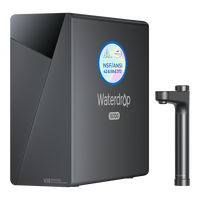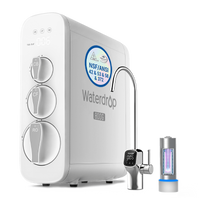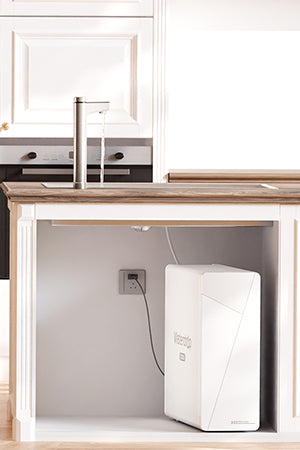Water is life, yet not all water is necessarily safe to drink. In Canada, although tap water in cities is treated and safe in most areas, boiling water to kill bacteria questions have been asked repeatedly. Canadians have tended to boil water as a means to purify water while camping, during emergencies, or in questionable water sources. But will boiling water kill all bacteria? Let's see how this mystery unfolds and learn much more about safe water behavior.
What Occurs During Boiling Water?
Boiling water is another ancient and simple method to make it pure. That water which gets to 100°C (212°F) at sea level starts to bubble and turns into vapor. Such high temperature destroys a lot of microorganisms, such as bacteria, viruses, and protozoa.
Boiling water for 1-3 minutes typically destroys the majority of disease-producing bacteria like E.coli,
Salmonella , and
Listeria . At elevated elevations, where water boils at lower elevations of heat, experts caution boiling water for at least 3 minutes to make it safe.
But you should know that boiling, though very effective, it won't get all contaminants out. Some spores of bacteria, chemical contaminants, heavy metals, and poisons cannot get killed with heat. That's to say that boiling water to make water safe to consume won't always do.
Are All Bacteria Killed at the Boiling Point?
The short answer: No, boiling water kills no bacteria.
1. Heat-Resistant Bacterial Spores
Some bacteria, like
Clostridium botulinum , produce spores that have the ability to withstand boiling heat. Though the spores in water are harmless, if they get into the water and then get into suitable conditions inside the body upon consumption, they will create toxins.
2. Chemical Contamination
Boiling water will not strip away chemicals such as pesticides, heavy metals, or PFAS (per- and polyfluoroalkyl substances). All these contaminants are found to rise in Canadian water sources and need filtration systems that go beyond boiling.
3. Viruses and Bacteria
Most viruses and bacteria are killed by boiling water, while some protozoan cysts such as Cryptosporidium have high heat resistance. Though it's unusual in Canadian potable water, it exists in unpurified sources such as lakes, streams, or holes.
How Long Should You Boil Water for Safety?
Health organizations such as Health Canada advise water to a rolling boil to kill most bacteria, viruses, and protozoa at least 1 minute. At water elevations higher than 2,000 meters (6,562 feet), boil water 3 minutes.
- 1 minute at sea level: Destroy most microbes.
- 3 minutes at high elevations: Provides immunity to all typical pathogens.
Whereas boiling works well to make water safe microbiologically, it neither enhances palatability nor prevents sediment and chemicals. That accounts for Canadians buying filtration systems at home that they can use on a daily basis.
Why Boiling Water Might Not Be Enough in Canada
While Canadian municipal tap water has stringent regulations in place, you will still have those occasional times where boiling won't quite do:
1. Aging Pipes
Older water systems may transfer metals such as lead into water. Boiling water will not strip away these metals, and in some situations, even escalate them.
2. Dirty Wells or Distant Sources
Secluded wells or water from surfaces carry the risk of bacteria, viruses, and protozoa. Boiling reduces microorganisms but no help in sediment and chemical pollutants.
3. Chemical Contamination
Since it was described previously, boiling cannot remove PFAS, by-products of chlorine, and other industrial contaminants. Long-term exposure may influence health.
In such instances, it's not the most efficient idea to depend on boiling water alone. Canadians looking at safe and pure drinking water have considered
reverse osmosis (RO) water filters or high-tech filtration systems.
What are the Better Substitutes to Boiling Water?
In Canadians seeking safe and pure water at home that tastes good, water filtration systems highly come to mind.
1. Reverse Osmosis (RO) Filtration Systems
RO systems, such as
Waterdrop reverse osmosis filters , eliminate bacteria, viruses, heavy metals, chemicals, and particulates. RO systems also give you complete water purification, which makes water safe to gulp down straight from the faucet compared to boiling.
Advantages of Waterdrop RO systems:
- Eliminate up to 99% contaminants
- Enhance water flavor by reducing chlorine and smells
- Energy and time saving in relation to boiling
- Simple installation and maintenance
2. Activated Carbon Filters
Carbon filters enhance flavor and reduce chlorine, pesticides, and select
volatile organic compounds (VOCs) . They don't remove viruses and bacteria very well.
3. Ultraviolet (UV) Purification
UV filters have the ability to inactivate viruses and bacteria in water and also cannot filter out heavy metals or chemicals.
RO filtration with UV and carbon filtration guarantees ultimate protection where possible since in homes in Canada where chemical contaminants and heavy metals pose a risk.
Tips for Canadians to Ensure Safe Drinking Water
Know Your Water Source
Test your city's yearly water quality report or your personal well for contaminants.
Apply Filtration Systems
Choose a Waterdrop RO system or an NSF International certified filter to eliminate both microbes and drugs.
Boiling in Emergencies
In case your water becomes contaminated with the help of natural disasters or boil-water advisories, carry it to a rolling boil for 1–3 minutes.
Regular Maintenance
Change filters as directed to make the system function optimally. Store Water Appropriately Even filtered or boiled water may get spoiled if kept in non-clean vessels.
Conclusion: Boiling Water versus Filtration
Boiling water is a reliable, uncomplicated process to kill numerous pathogenic microorganisms, yet it cannot always make water completely safe, primarily due to the occurrence of its ingredients that are heat-resistant spores and chemical contaminants. Canadians who wish to have safe, pure, and delicious water in the comfort of homes may want to consider acquiring a Waterdrop reverse osmosis water filter.
With RO filtration, you have the comfort in knowing that your water is safe from bacteria, viruses, heavy metals, and chemicals—an aspect that boiling alone cannot fulfill. Integrating correct filtration with good water hygiene practice guarantees that each glass you take is safe and safe to drink. Remember: Boiling is a great emergency solution, but for everyday health, clean water filters like Waterdrop RO systems are the smartest choice.










































































